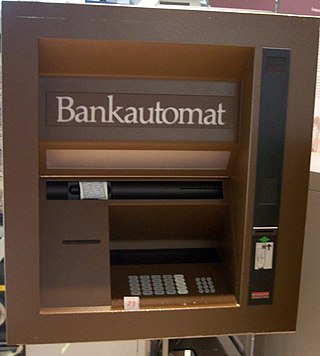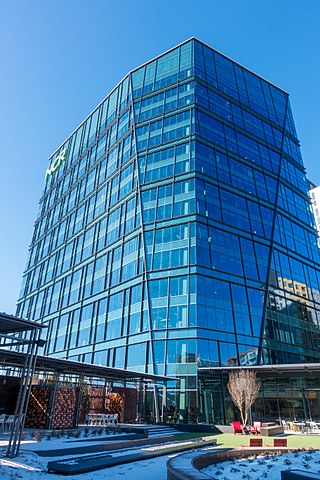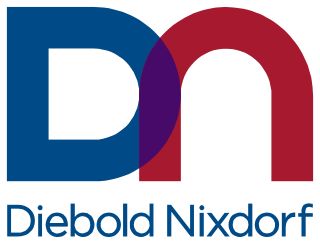Related Research Articles

In computing, a printer is a peripheral machine which makes a durable representation of graphics or text, usually on paper. While most output is human-readable, bar code printers are an example of an expanded use for printers. Different types of printers include 3D printers, inkjet printers, laser printers, and thermal printers.

An automated teller machine (ATM) is an electronic telecommunications device that enables customers of financial institutions to perform financial transactions, such as cash withdrawals, deposits, funds transfers, balance inquiries or account information inquiries, at any time and without the need for direct interaction with bank staff.

NCR Voyix Corporation, previously known as NCR Corporation and National Cash Register, is an American software, consulting and technology company providing several professional services and electronic products. It manufactured self-service kiosks, point-of-sale terminals, automated teller machines, check processing systems, and barcode scanners.

The point of sale (POS) or point of purchase (POP) is the time and place at which a retail transaction is completed. At the point of sale, the merchant calculates the amount owed by the customer, indicates that amount, may prepare an invoice for the customer, and indicates the options for the customer to make payment. It is also the point at which a customer makes a payment to the merchant in exchange for goods or after provision of a service. After receiving payment, the merchant may issue a receipt, as proof of transaction, which is usually printed but can also be dispensed with or sent electronically.

Diebold Nixdorf is an American multinational financial and retail technology company that specializes in the sale, manufacture, installation and service of self-service transaction systems, point-of-sale terminals, physical security products, and software and related services for global financial, retail, and commercial markets. Currently Diebold Nixdorf is headquartered in the Akron-Canton area with a presence in around 130 countries, and the company employs approximately 23,000 people. Founded in 1859 in Cincinnati, Ohio as the Diebold Bahmann Safe Company, the company eventually changed its name to Diebold Safe & Lock Company. In 1921, Diebold Safe & Lock Company sold the world's largest commercial bank vault to Detroit National Bank. Diebold has since branched into diverse markets, and is currently the largest provider of ATMs in the United States. Diebold Nixdorf was founded when Diebold Inc. acquired Germany's Wincor Nixdorf in 2016. It is estimated that Wincor Nixdorf controls about 35 percent of the global ATM market.

A water dispenser, sometimes referred to as a water cooler, is a machine that dispenses and often also cools or heats up water with a refrigeration unit. It is commonly located near the restroom due to closer access to plumbing. A drain line is also provided from the water cooler into the sewer system.
The term dispenser typically imply a machine or container which is designed to release a specific amount of its content, usually liquids or powders/fine granular materials.
IBM manufactured magnetic disk storage devices from 1956 to 2003, when it sold its hard disk drive business to Hitachi. Both the hard disk drive (HDD) and floppy disk drive (FDD) were invented by IBM and as such IBM's employees were responsible for many of the innovations in these products and their technologies. The basic mechanical arrangement of hard disk drives has not changed since the IBM 1301. Disk drive performance and characteristics are measured by the same standards now as they were in the 1950s. Few products in history have enjoyed such spectacular declines in cost and physical size along with equally dramatic improvements in capacity and performance.
The Atari 2700 is a prototype home video game console that was developed by Atari, Inc. to be a wirelessly controlled version of Atari's popular Atari 2600 system. Intended for release in 1981, the 2700 was one of several planned follow-ups to the 2600, but the system was never put into full production. While It is unclear how many of these systems exist, former Atari employee Dan Kramer has stated that at least 12 consoles were made, plus extra controllers.

The IBM 3624 was released in 1978 as a second-generation automatic teller machine (ATM), a successor to the IBM 3614. Designed at the IBM Los Gatos lab, the IBM 3624, along with the later IBM 4732 model, was manufactured at IBM facilities in Charlotte, North Carolina and Havant, England until all operations were sold to Diebold, tied to the formation of the InterBold partnership between IBM and Diebold. Comparable ATM units marketed by other companies at the time were the Diebold TABS 9000 and NCR 5xxx.

Wincor Nixdorf was a German corporation that provided retail and retail banking hardware, software, and services. Wincor Nixdorf was engaged primarily in the sale, manufacture, installation and service of self-service transaction systems, retail banking equipment, lottery terminals, postal terminals, software and services for global financial and commercial markets.
Teller Assist Units (TAU), also known as Automatic Teller Safes (ATS) or Teller Cash Dispensers (TCD), are devices used in retail banking for the disbursement of money at a bank teller wicket or a centralized area. Other areas of application of TAU include the automation of starting and reconciling teller or cashier drawers (tills) in retail, check cashing, payday loan / advance, grocery, and casino operations.

Automated cash handling refers to the process of dispensing, counting, and tracking cash within various business environments using software and hardware devices such as banknote processing. Automated cash handling is used by banks, retail stores, check-cashing outlets, payday loan/advance providers, casinos, and more. This process is facilitated through the use of specially designed hardware and software, with the primary goals of preventing loss, deterring theft, and reducing the need for constant manual oversight of cash operations.

The toothpaste pump, also known as a toothpaste pump dispenser, is a device used to contain and dispense toothpaste, akin to a tube. An automatic toothpaste dispenser is a self-starting way to dispense toothpaste.

An instant hot water dispenser or boiling water tap is an appliance that dispenses water at about 94 °C (201 °F) (near-boiling). There are hot-only and hot and cool water models, and the water may be filtered as well as heated. Instant hot water dispensers became popular in the 1970s. Instant hot water dispensers are very similar to portable shower devices; the latter is fitted with a heating element and quickly heats up water, once a switch has been activated.
The IBM 3570 is a series of tape drives and corresponding magnetic tape data storage media formats developed by IBM. The storage technology and media were introduced using the name Magstar MP, combining the IBM storage brand name Magstar with MP for MultiPurpose. The IBM product number 3570 was associated with the tape drives and libraries that used the Magstar MP media.

Drum pump, barrel pump, and transfer pump refer to pumps that are used to empty barrels, tanks, IBCs and drums. Many liquids used on manufacturing and processing plants are delivered in 100 or 200 litre barrels and are too heavy to tip to empty the liquids inside. Drum pumps range from simple siphon based devices to sophisticated highly-engineered machinery.

The IBM Selectric was a highly successful line of electric typewriters introduced by IBM on 31 July 1961.
Barnaby Michael Douglas Jack was a New Zealand hacker, programmer and computer security expert. He was known for his presentation at the Black Hat computer security conference in 2010, during which he exploited two ATMs and made them dispense fake paper currency on the stage. Among his other most notable works were the exploitation of various medical devices, including pacemakers and insulin pumps.
References
- ↑ "Error - 404". Archived from the original on 2016-03-04. Retrieved 2016-07-12.
- ↑ "About Us - History - Today". Archived from the original on 2006-08-13. Retrieved 2006-07-27.